Launching the #CPUOverload Project: Testing Every x86 Desktop Processor since 2010
by Dr. Ian Cutress on July 20, 2020 1:30 PM ESTCPU Tests: Science
In this version of our test suite, all the science focused tests that aren’t ‘simulation’ work are now in our science section. This includes Brownian Motion, calculating digits of Pi, molecular dynamics, and for the first time, we’re trialing an artificial intelligence benchmark, both inference and training, that works under Windows using python and TensorFlow. Where possible these benchmarks have been optimized with the latest in vector instructions, except for the AI test – we were told that while it uses Intel’s Math Kernel Libraries, they’re optimized more for Linux than for Windows, and so it gives an interesting result when unoptimized software is used.
3D Particle Movement v2.1: Non-AVX and AVX2/AVX512
This is the latest version of the benchmark designed to simulate semi-optimized scientific algorithms taken directly from my doctorate thesis. This involves randomly moving particles in a 3D space using a set of algorithms that define random movement. Version 2.1 improves over 2.0 by passing the main particle structs by reference rather than by value, and decreasing the amount of double->float->double recasts the compiler was adding in.
The initial version of v2.1 is a custom C++ binary of my own code, flags are in place to allow for multiple loops of the code with a custom benchmark length. By default this version runs six times and outputs the average score to the console, which we capture with a redirection operator that writes to file.
For v2.1, we also have a fully optimized AVX2/AVX512 version, which uses intrinsics to get the best performance out of the software. This was done by a former Intel AVX-512 engineer who now works elsewhere. According to Jim Keller, there are only a couple dozen or so people who understand how to extract the best performance out of a CPU, and this guy is one of them. To keep things honest, AMD also has a copy of the code, but has not proposed any changes.
The final result is a table that looks like this:
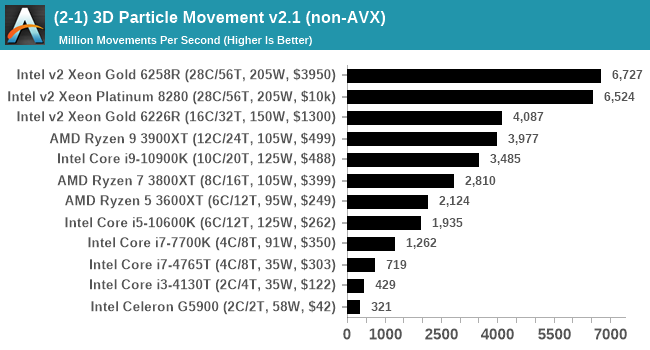
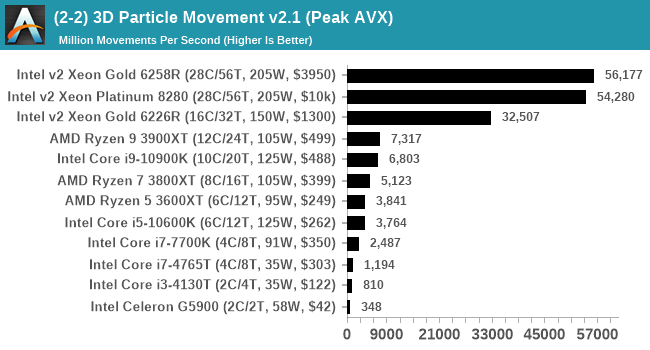
The 3DPM test is set to output millions of movements per second, rather than time to complete a fixed number of movements. This way the data represented becomes a linear when performance scales and easier to read as a result.
y-Cruncher 0.78.9506: www.numberworld.org/y-cruncher
If you ask anyone what sort of computer holds the world record for calculating the most digits of pi, I can guarantee that a good portion of those answers might point to some colossus super computer built into a mountain by a super-villain. Fortunately nothing could be further from the truth – the computer with the record is a quad socket Ivy Bridge server with 300 TB of storage. The software that was run to get that was y-cruncher.
Built by Alex Yee over the last part of a decade and some more, y-Cruncher is the software of choice for calculating billions and trillions of digits of the most popular mathematical constants. The software has held the world record for Pi since August 2010, and has broken the record a total of 7 times since. It also holds records for e, the Golden Ratio, and others. According to Alex, the program runs around 500,000 lines of code, and he has multiple binaries each optimized for different families of processors, such as Zen, Ice Lake, Sky Lake, all the way back to Nehalem, using the latest SSE/AVX2/AVX512 instructions where they fit in, and then further optimized for how each core is built.
For our purposes, we’re calculating Pi, as it is more compute bound than memory bound. In single thread mode we calculate 250 million digits, while in multithreaded mode we go for 2.5 billion digits. That 2.5 billion digit value requires ~12 GB of DRAM, so for systems that do not have that much, we also have a separate table for slower CPUs and 250 million digits.
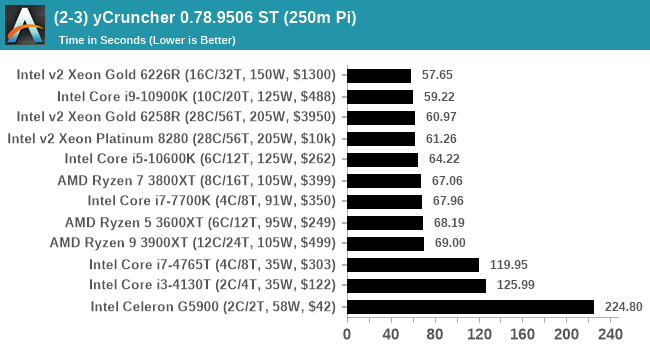
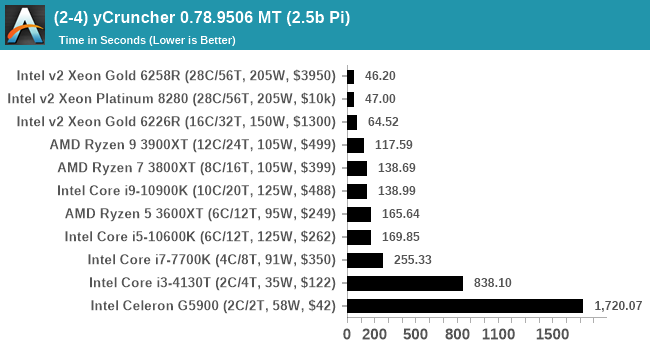
y-Cruncher is also affected by memory bandwidth, even in ST mode, which is why we're seeing the Xeons score very highly despite the lower single thread frequency.
Personally I have held a few of the records that y-Cruncher keeps track of, and my latest attempt at a record was to compute 600 billion digits of the Euler-Mascheroni constant, using a Xeon 8280 and 768 GB of DRAM. It took over 100 days (!).
NAMD 2.13 (ApoA1): Molecular Dynamics
One of the popular science fields is modelling the dynamics of proteins. By looking at how the energy of active sites within a large protein structure over time, scientists behind the research can calculate required activation energies for potential interactions. This becomes very important in drug discovery. Molecular dynamics also plays a large role in protein folding, and in understanding what happens when proteins misfold, and what can be done to prevent it. Two of the most popular molecular dynamics packages in use today are NAMD and GROMACS.
NAMD, or Nanoscale Molecular Dynamics, has already been used in extensive Coronavirus research on the Frontier supercomputer. Typical simulations using the package are measured in how many nanoseconds per day can be calculated with the given hardware, and the ApoA1 protein (92,224 atoms) has been the standard model for molecular dynamics simulation.
Luckily the compute can home in on a typical ‘nanoseconds-per-day’ rate after only 60 seconds of simulation, however we stretch that out to 10 minutes to take a more sustained value, as by that time most turbo limits should be surpassed. The simulation itself works with 2 femtosecond timesteps.
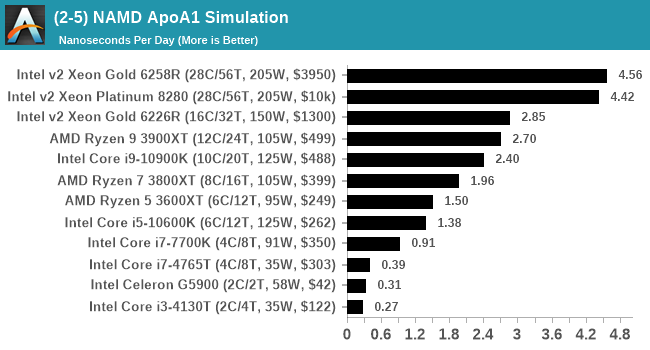
How NAMD is going to scale in our testing is going to be interesting, as the software has been developed to go across large supercomputers while taking advantage of fast communications and MPI.
AI Benchmark 0.1.2 using TensorFlow: Link
Finding an appropriate artificial intelligence benchmark for Windows has been a holy grail of mine for quite a while. The problem is that AI is such a fast moving, fast paced word that whatever I compute this quarter will no longer be relevant in the next, and one of the key metrics in this benchmarking suite is being able to keep data over a long period of time. We’ve had AI benchmarks on smartphones for a while, given that smartphones are a better target for AI workloads, but it also makes some sense that everything on PC is geared towards Linux as well.
Thankfully however, the good folks over at ETH Zurich in Switzerland have converted their smartphone AI benchmark into something that’s useable in Windows. It uses TensorFlow, and for our benchmark purposes we’ve locked our testing down to TensorFlow 2.10, AI Benchmark 0.1.2, while using Python 3.7.6 – this was the only combination of versions we could get to work, because Python 3.8 has some quirks.
The benchmark runs through 19 different networks including MobileNet-V2, ResNet-V2, VGG-19 Super-Res, NVIDIA-SPADE, PSPNet, DeepLab, Pixel-RNN, and GNMT-Translation. All the tests probe both the inference and the training at various input sizes and batch sizes, except the translation that only does inference. It measures the time taken to do a given amount of work, and spits out a value at the end.
There is one big caveat for all of this, however. Speaking with the folks over at ETH, they use Intel’s Math Kernel Libraries (MKL) for Windows, and they’re seeing some incredible drawbacks. I was told that MKL for Windows doesn’t play well with multiple threads, and as a result any Windows results are going to perform a lot worse than Linux results. On top of that, after a given number of threads (~16), MKL kind of gives up and performance drops of quite substantially.
So why test it at all? Firstly, because we need an AI benchmark, and a bad one is still better than not having one at all. Secondly, if MKL on Windows is the problem, then by publicizing the test, it might just put a boot somewhere for MKL to get fixed. To that end, we’ll stay with the benchmark as long as it remains feasible.
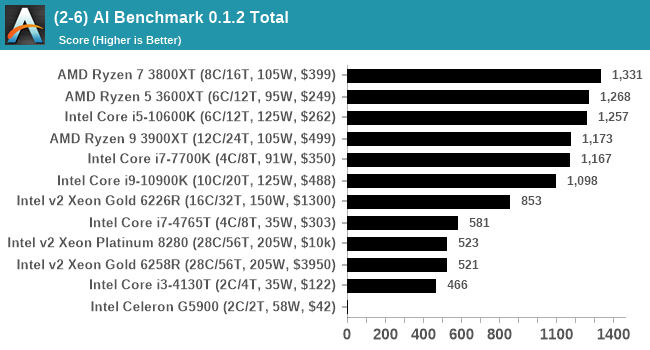
As you can see, we’re already seeing it perform really badly with the big chips. Somewhere around the Ryzen 7 is probably where the peak is. Our Xeon chips didn't really work at all.


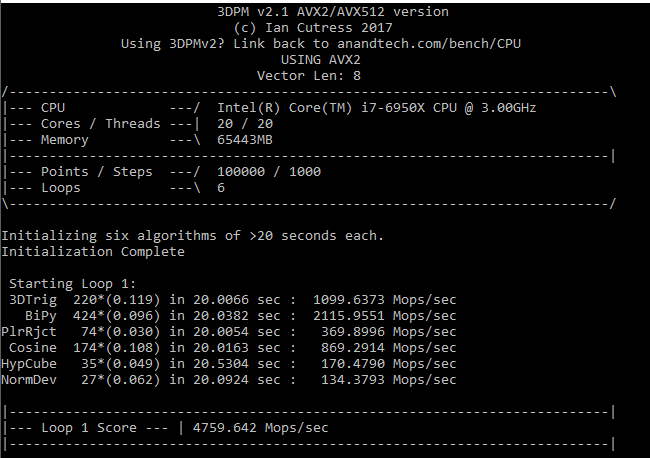
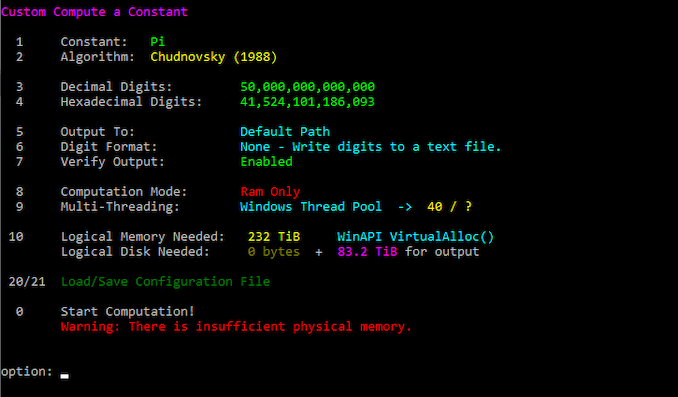
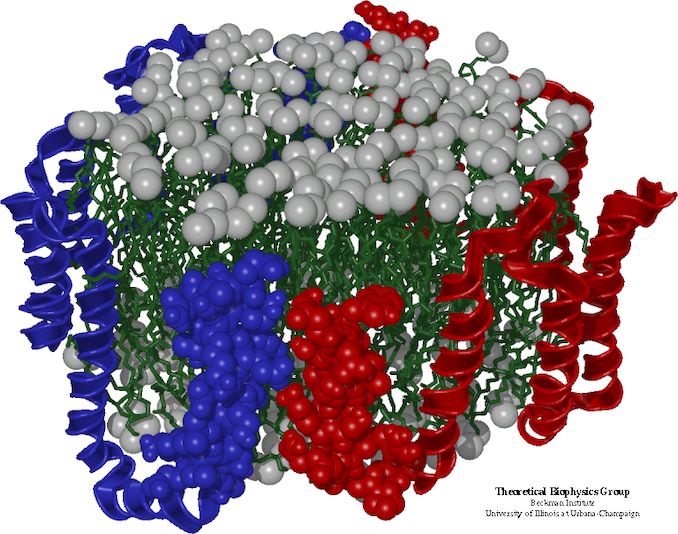









110 Comments
View All Comments
Sootie - Tuesday, July 21, 2020 - link
Any chance of a crowd sourced version of the bench? People with unusual CPU's could run a cut down version of the bench with only software that does not require a license and heavily disclaimed that it was not an official run just to add a few more data points of rare devices. I have a whole museum of old servers I can run some tests on but it's not practical to send them elsewhere.I'm a big fan of all the work you have done and are doing on the bench though I use it constantly for work and home.
Tilmitt - Tuesday, July 21, 2020 - link
Phenom II X6 and X4 would be cool to see if the "more cores make future proof" narrative actually holds up.lmcd - Tuesday, July 21, 2020 - link
X6 outperformed early Bulldozer 8 cores by a notable bit if that's of any interest.loads2compute - Tuesday, July 21, 2020 - link
Dear Ian,Wow! What a nice idea to test all these legacy processors on modern benchmarks. I think it is a great idea!
But als wow, what an enormous effort you are taking on automating all that stuff, starting from scratch and using autohotkey as your main tool. It seems like going to an uninhabited island, starting civilization from scratch and taking a tin opener as your main tool.
In my line of work (bioinformatics) we have to automate a load of consecutive tasks. Luckily there are frameworks for this, which make the work a lot easier.
Luckily there is already a framework for automated testing and benchmarking which happens to work on Linux, Mac and Windows (and even BSD). It is called the phoronix test suite http://phoronix-test-suite.com/. It can be extended with modules, so you could integrate all your desired tests in there. There is even paid support available, but since they guy who runs this (Michael Larabel) is working on a fellow tech outlet (phoronix.com) I am sure you can work something out to your mutual benefit. No doubt he is interested in all these old processor benchmarks too!
The phoronix test suite also comes with phoromatic, which according to the website : "allows the automatic scheduling of tests, remote installation of new tests, and the management of multiple test systems all through an intuitive, easy-to-use web interface."
So please do not start from scratch and do this yourself! Use this great open-source tool that is already available and consequently you will be able to get a lot more work done on the stuff that actually interests you! (I take it AHK scripting is not your hobby).
Ian Cutress - Tuesday, July 21, 2020 - link
Scripts are already done :)The issue is that a lot of tests have a lot of different entry points; with AHK I can customizer for each. I've been using it for 5 years now, so coding isn't an issue any more.
Fwiw, I speak with Michael on occasion. We go to the same industry events etc
eek2121 - Tuesday, July 21, 2020 - link
Was procuring a new GPU really that hard? I am going to blame your owner on this one. If you were an independent website I honestly would have purchased a 2080ti and donated it to you. It honestly seems like not being independent is hurting you more than it is helping. Without going into specifics, I know of websites smaller than AT that can afford at least 3 good full time writers and a bunch of awesome hardware.I have toyed with the idea of starting an alternative site where all hardware is procured in the retail channel. I know what advertising rates are like and I know that using affiliates, sponsorships, and advertising more than cover the cost of a few models per generation. Maybe it’s time AT staff strike out on their own. Just a thought.
Outside of that, I look forward to future endeavors.
Ian Cutress - Tuesday, July 21, 2020 - link
Procuring a GPU is always difficult, as we don't have the bandwidth to test AIB cards any more.Fwiw AT only has 2/3 FT writers.
If we were to spin back out, we'd need investors and a strategy.
Igor_Kavinski - Tuesday, July 21, 2020 - link
Request: Core i7-7700K DDR3 benchmarks (There are Asus and Gigabyte mobos that allow DDR3 to be used) to compare with Core i7-7700K DDR4 benchmarks. Thanks!Xex360 - Tuesday, July 21, 2020 - link
Very fascinating.dad_at - Tuesday, July 21, 2020 - link
Pls include HEDT Sandy Bridge E: one of Core i7 3960X, 3970X, 3930K, etc. Once it was present in the CPU bench, but you removed it since 2017...